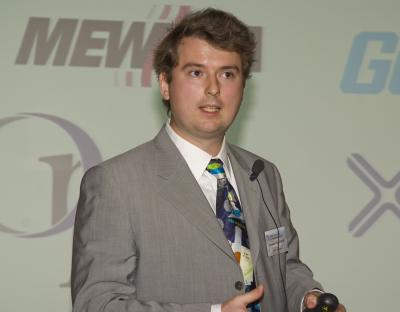- Home
- News
- General News
- New-look Users'...
New-look Users' Meeting attracts more users
12-02-2010
The ESRF Users’ Meeting has always been a forum for the users and the management, where new scientific challenges are discussed and recent achievements are presented. This year there have been more talks in different fields in order to cater for a wider scientific audience. Feedback sessions were also new in the programme and their goal was to boost the communication between communities and the ESRF. The new 2-day approach responds to an initiative by the Users’ Organisation, and the 321 participants show that the success is notable.
Share
This year, the Users’ Meeting started with a keynote lecture on magnetism, followed by another one on glycobiology: two very different talks, which set the scene for a meeting that covered more subjects than previously, with four more scientific talks on the second day. One particularly noteworthy aspect of the work presented was how using complementary techniques, both X-ray and non-X-ray techniques, allows a more complete picture of the sample or processes investigated to be built. This confirms that the ESRF’s commitment to trying to set up partnerships in various fields to benefit from different technical platforms is certainly a step in the right direction.
Another new incursion in the Users’ Meeting was the session on feedback from the Parallel sessions and discussion with the directors. The idea of these sessions was to bring together scientists from different communities, who had been discussing separately about the new challenges in their field during the parallel sessions. The occasion was also an opportunity to interact with the management of the ESRF. “This is a new aspect of the Users’ Meeting that benefited many of our users, especially when they realized that maybe their scientific or technical goals could have similarities with other researchers from different disciplines”, explains Joanne Mc Carthy, head of the Users’ Office at the ESRF.
Young Scientist Award goes to energy researcher
A more traditional part of the Users’ Meeting is the presentation of the Young Scientist Award. Yaroslav Filinchuk is the recipient of the prize in 2010 for “his outstanding work on the chemistry of solid state hydrides”. This Ukrainian chemist has worked at the Swiss–Norwegian Beamline (BM1) at the ESRF since 2006. He is currently a visiting professor at the University of Aarhus (Denmark). When asked about the meaning of the prize, he says: “It means having my research activity of my academic project publicly recognised. Reputation is difficult to build up – it’s not just about writing a large amount of papers for publication. I am very pleased that scientists from other areas recognise our work as an achievement in this rapidly developing field of research. It also gives me more confidence and helps me to move forward.”
 |
|
Yaroslav Filinchuk, winner of the Young Scientist Award, giving his talk during the Users' Meeting. Credits: C. Argoud. |
The best poster award went to Amélie Juhin, for her poster on “Strong K-edge X-ray Magnetic Circular Dichroism detected by Resonant Inelastic X-ray Scattering”.
Two workshops took place the same week as the Users’ Meeting: one was on nanobeams and the other on extreme conditions. The latter is very timely, as the preparation for a Partnership for Extreme Conditions is developing swiftly. The Users’ Meeting also had a School on Macromolecular Crystallography for the second year in a row.
Top image: The coffee break of the workshop on nanobeams.



